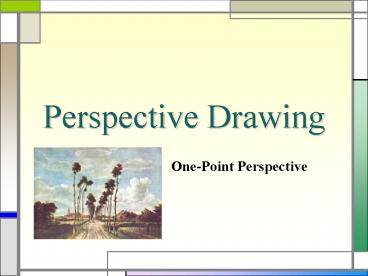Perspective Drawing PowerPoint PPT Presentation
Title: Perspective Drawing
1
Perspective Drawing
- One-Point Perspective
2
Perspective
- During the Renaissance artists became interested
in making two-dimensional artwork look
three-dimensional. - Renaissance- (1450-1600) The Renaissance began
in Italy and spread through Northern Europe. Art,
Science, and Literature grew during this time.
3
Perspective
- Many of the earlier works artists created showed
little depth. - Does this picture reflect depth? Why or why not?
- How could this picture be changed to increase
its depth?
Kaufmann Haggadah. Spain, late 14th C.
4
Perspective
- Artists used mathematics and close observation to
invent linear perspective. - Linear perspective allows artists to trick the
eye into seeing depth on a flat surface.
5
PerspectiveInfluential People during the
Renaissance
- Art
- Michelangelo
- Leonardo da Vinci
- Science
- Galileo
- Literature
- Shakespeare
Raphael, School of Athens, One-point linear
perspective
6
Perspective
- Many artists have used a variety of different
techniques to show depth. However it was not
until the Renaissance that artists developed a
system to show depth logically and consistently.
7
Perspective
- Linear Perspective
- Based on the way the human eye sees the world.
- Objects that are closer appear larger, more
distant objects appear smaller. - To create the illusion of space the artists
creates a vanishing point on the horizon line. - Objects are drawn using orthogonal lines, which
lead to the vanishing points.
8
Perspective
- Vanishing Point
- The single point on the horizon where all the
lines on the ground level seem to come together - Horizon Line
- The place where the land and the sky meet.
- Orthogonal Line
9
Perspective
- Can you locate the Horizon Line?
- How did you determine this?
- Can you find the vanishing point in this picture?
10
Perspective
The red line is the Horizon Line.
11
Perspective
Can you locate the vanishing point?
12
Perspective
- Artists use one-point perspective to show objects
face-on. - Most lines are vertical, horizontal, or
orthogonal drawn to a single vanishing point.
13
Perspective
- The Horizon Line is horizontal, it goes from left
to right and is parallel to the bottom edge of
the picture. - Represents the viewers eye level.
- It is the place where the ground and the sky seem
to meet - You can see the top of an object if it is below
eye level, below the Horizon Line. - If an object is above eye level, above the
Horizon Line, you can not see its top.
14
Perspective
Place a dot in the middle of the Horizon Line.
This is your vanishing point. In one-point
perspective the Vanishing Point, represented is
always on the Horizon Line. As things get closer
to the Vanishing Point they get smaller and
smaller until they appear to vanish.
15
Perspective
Draw a square or rectangle In your picture plane.
16
Perspective
Now connect three corners of your rectangle or
square to the vanishing point. These are
orthogonals.
17
Perspective
Draw a horizontal line between the two
orthogonals where you want your forms to end.
18
Perspective
Vertical lines go from the top of the page to
bottom of the page and are perpendicular to the
bottom edge of the picture. Along with orthogonal
and horizontal lines they make up a one-point
perspective drawing.
19
Perspective
Erase the orthogonals to complete your form. You
now have a 3-D form in one-point perspective.
20
Perspective

